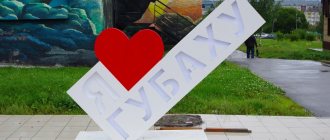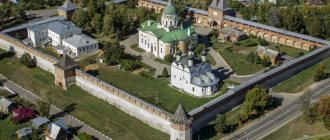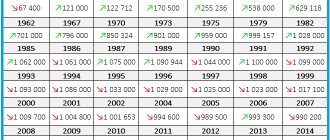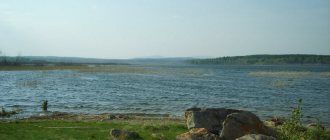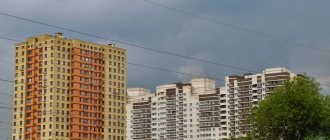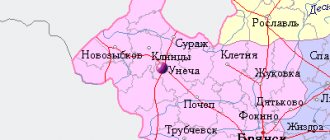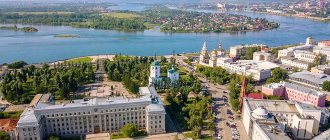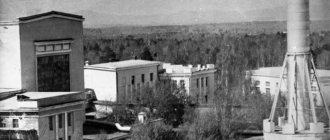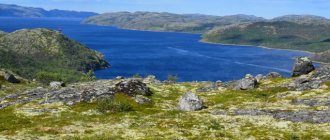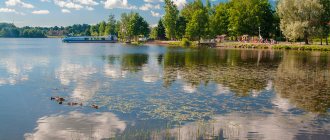The large Neva River has a small tributary, Izhora, on the banks of which the town of Kolpino was founded in 1722. Now it is considered a district of St. Petersburg, only 26 km separates it from the center of the northern capital, about half an hour by train or 20-25 minutes by minibus. The sights of Kolpino, of course, are not as impressive in scale as those in St. Petersburg, but we assure you that there is something to see here too. Walking around Kolpino and reading the signs with street names, you get the impression that you are in the USSR - Komsomolskaya, Proletarskaya, Sovetskaya and, of course, the monument to Lenin. As soon as you see blocky multi-story buildings from the 1980s, you know that you have entered the area that the townspeople call Prostokvashino. From here we will begin our acquaintance with the city and present you with the main attractions of Kolpino with their photographs and descriptions.
General information and history of the area
Kolpinsky district is one of the administrative-territorial units of St. Petersburg.
It is located in the southeast of the city, on the banks of the Izhora River. The district includes 6 municipalities, of which the largest is the city of Kolpino, which actually gave the district its name. In addition to it, the district includes the villages of Petro-Slavyanka, Metallostroy, Ust-Izhora, Pontonny and Saperny. Total area – 105 sq. km. (4th largest in St. Petersburg), stretches from northwest to southeast for almost 20 km, and from west to east - 8, about 180 thousand inhabitants live on its territory. It borders with the Frunzensky, Nevsky and Pushkinsky districts of St. Petersburg, as well as with the Vsevolozhsky, Kirovsky and Tosnensky districts of the Leningrad Region. Kolpino arose in 1722 as a workers’ settlement at the state-owned Izhora Admiralty factories. The peasants assigned to the enterprise chose the right bank of the Izhora River as their future home. In 1912, Kolpino was awarded the title of “city”. 21 years earlier, the posad was granted its own Coat of Arms and the right of self-government.
In the same year (1881) the first Kolpino Duma was elected. Kolpino received the status of an urban district only in 1954. During the Great Patriotic War, Kolpino residents, despite the blockade and famine, continued to supply tanks and ammunition to the army. There was even a school during the siege. By the combined forces of the army, Kolpino and Izhora people, the Nazis were stopped 4 km away. to the city and 30 km. to Leningrad.
The Kolpino district is located quite far from the city center (25 km) and can be considered more of a suburb. The territory of the district is occupied mainly by industrial warehouse complexes and cargo terminals. This is greatly facilitated by the federal highway E-105 (Moscow-St. Petersburg), which passes through the territory, considered the main transport artery of the country, and a branch of the Oktyabrskaya Railway. A network of passenger and cargo terminals at Pulkovo Airport is located nearby. In a word, the transport and geographical position of the area is extremely favorable; it is sometimes called St. Petersburg’s gateway to “greater Russia” - the central and eastern regions, as well as the northern regions of the country (Murmansk, Vologda and others).
The area is quite unique - initially created as an industrial center, it still adheres to this vector of development. This allows the administration to guarantee residents a large number of jobs plus good prospects for development and financing. More than 3,500 different enterprises are registered on the territory, of which 17 are the largest in the city. Today, these enterprises produce about 70% of industrial products and are able to provide jobs for more than half of the working population of the region.
Transport links are well developed, both inside and outside the area - if you're lucky, you can get to the center in about half an hour - 40 minutes. A fly in the ointment is added by constant traffic jams on the Moscow highway (usually in the Shushar area), in which you can lose from 20 minutes to several hours. Plus, electric trains, which are a natural alternative to buses and minibuses, are sometimes so filled that people ride almost on their roofs. In addition, due to the introduction of high-speed Sapsan trains, the train schedule was changed, some of them were completely canceled.
In cramped conditions, but without traffic jams.
Despite the large concentration of industrial facilities, the air in residential areas is clean and tasty. This is mainly due to the large greenery, forests and successfully blowing south-east winds, which carry smog and industrial exhausts away.
Monuments
- No wonder the residents of Kolpino named the microdistrict, as in their favorite cartoon, Prostokvashino. After all, here is a monument to its main characters - the postman Pechkin, the cat Matroskin and the dog Sharik. Where Remizov Street intersects with Tverskaya, everyone’s favorite animated trio is located. The sculptural composition was installed recently - in 2012. The initiative came from the city administration, and the opening of the monument was timed to coincide with the 290th anniversary of Kolpino. He quickly gained popularity; local children, their parents, as well as guests of the city certainly take photographs while sitting on the bench next to Pechkin. And everyone strokes Sharik and Matroskin on the ear or nose, they say that at this moment you need to make a wish and it will definitely come true.
- If you have enough time for walking, you can also see the monument to the favorite of Peter I and his closest associate Alexander Danilovich Menshikov, thanks to whom the city of Kolpino arose. It is located in a park on the left bank of the Izhora Razliv.
- On Svobody Boulevard there is a large monument to the Izhora heroes. The place where it is located was mercilessly shelled by the German invaders during the siege of Leningrad, then the townspeople called it “the isthmus of death.” In 1959, a memorial monument was opened here - a wall that does not allow Kolpino residents and tourists to forget about the feat the Soviet people accomplished during the war. On holidays, a fire burns here, just like on the St. Petersburg Rostral Columns.
Ecology of the area
Despite the huge number of industrial facilities that negatively affect the ecology of the area, Kolpino is considered one of the cleanest and most beautiful areas of the city. This is due to the fact that great attention is paid to environmental problems here. The situation is corrected by a favorable wind rose, a large number of forests around the city and good greenery in the area as a whole (the total area of parks and gardens is almost 200 hectares).
Soil pollution is also not critical - only 12% of the territory is classified as “dangerous”, the rest are zones of “moderately dangerous” and “permissible” levels of pollution. The water in some rivers is critically polluted - for example, in Izhorka and Slavyanka, swimming has been prohibited for many years, and swimming in other reservoirs in the region is risky. However, on hot summer days, the ban is constantly violated and hundreds of residents climb into the dirty waters in search of the desired coolness, forgetting about their own health. But the situation is gradually improving - decent money is allocated annually for water purification, so there is hope for the best.
Park in Kolpino
The air in residential areas is sometimes cleaner than in the city. All thanks to the southeastern direction of the winds, which carry “dirty” air masses away and, in return, bring clean and fresh air from the forest areas.
In addition to industry, motor transport has a negative (albeit significantly less than enterprises) impact on the environment. The largest highway in Russia runs through the area, along which heavy trucks and cars flow continuously day and night. The town located 5 km away also contributes to environmental pollution. to the southeast is the Krasny Bor toxic waste disposal site. Despite the poetic name, this place cannot be called beautiful - moreover, the landfill has already outgrown the boundaries of its designated territory and may soon become a significant environmental threat to the city and region.
Population of the area
The population of the district is about 180 thousand people, of which 80% live in the city of Kolpino. At the moment, mortality exceeds birth rate, despite the constant increase in the latter. The birth record was set in July 2012 - in 1 month, as many as 254 babies were born (111 girls and 143 boys). This exceeded the normal birth rate by almost 2 times. If everything goes in the same spirit, Kolpino has a real chance to get out of the “minus growth”.
The most acute problem is life expectancy and the high mortality rate of citizens of working age (mainly men). Most people die from diseases of the circulatory system (about 60%), second place by a large margin is occupied by neoplasms - 17% (tumors, etc.). The third line of the sad list is occupied by accidents, injuries and poisonings.
The social composition of Kolpino and the villages is heterogeneous. The basis, of course, is made up of factory workers and engineers, managers of all stripes and logistics service employees. People of Slavic appearance predominate. But in recent years, there has been an increasing tendency to attract migrants from the southern regions to low-paid jobs in factories. It is due to the mechanical influx that up to two-thirds of the population growth is ensured (at the same time, the birth rate in the area is consistently maintained at one of the highest rates in the city).
The working population in the region is about 55%, while in recent years the number of pensioners has sharply increased. This is due to the relocation of pensioners on benefits from old communal apartments in the center of St. Petersburg to new buildings in the Kolpinsky district.
District division
Map of Kolpinsky district
Kolpinsky district is relatively young by city standards. It consists of 6 municipal districts: Kolpino, Ust-Izhora, Petro-Slavyanka, Metallostroy, Pontonny and Saperny. The center of the region is the city of Kolpino. Total area – 105 sq. km., which is less than 7% of the total area of St. Petersburg. The distance to the center of St. Petersburg is 25 km. It has common borders with the Pushkinsky district (in the west), Frunzensky and Nevsky (in the north) districts of St. Petersburg. In the south it borders with the Kirov and Tosnensky districts of the Leningrad Region. The northeastern border of the region stretches along the Neva River for approximately 20 km. There are many reservoirs in the region: the rivers Izhora, Kuzminka, Bolshaya and Malaya Izhorka, Slavyanka, Neva, streams (Bolshoy and Maly Izhortsy, Mogilny Stream, Popov Stream) and canals (Sovetsky and Komsomolsky). Main highways: Petrozavodskoe highway and Moskovskoe highway.
Kolpino
The largest settlement in the region, as well as in the entire Leningrad region. Also one of the largest industrial centers of St. Petersburg. A large number of shopping and entertainment centers, a number of chain stores “Pyaterochka”, “Magnit” and others. Well-developed infrastructure and transport links. True, endless traffic jams on the Moscow Highway and overcrowded trains somewhat spoil the picture.
Entrance to Kolpino
The city spreads freely on both banks of the Izhora River. The center of Kolpino is a dam on the river (Svoboda Boulevard). Another transport artery of the city is Lenin Avenue, which has actually become the axis connecting the city and the Izhora plant. The city has many kindergartens, schools and other institutions for children and teenagers. Unfortunately, one of them is the Kolpino educational colony, which currently houses about 50 juvenile offenders. In addition, Kolpino is rich in various cultural and artistic monuments and establishments where you can have an interesting rest.
The housing market in Kolpino is diverse - from low-rise buildings of the old stock to a few modern luxury new buildings. There are also panel houses and “Stalin” houses - in general, for every taste and budget. One-room apartments in Kolpino are one of the cheapest and most popular options for buying or renting housing. The most popular buildings are Stalinist buildings along Lenin Avenue and the “Prostokvashino district” - several blocks of buildings from the 80-90s (mostly modern panel houses of the 606 and 137 series). The cheapest apartments are in “kirovkas” - dilapidated low-rise buildings from the 1930s.
In the immediate vicinity of Kolpino, the village of Novaya Izhora (one- and two-story cottages of German construction) is being built. More than 300 houses have already been built, with plots of 3-4 acres attached to each. It is planned to build another 400 houses and provide the village with a fully developed infrastructure.
Metallostroy
Located 20 km. from St. Petersburg. Transport connections are provided by the Metallostroy railway station and the 19 kilometer public transport stop. The infrastructure of the village is well developed; there are schools, shops, libraries, a driving school, two stadiums and even a swimming pool.
Now Metallostroy is actually experiencing a “rebirth” - the once small village where the plant’s builders lived is rapidly turning into a neighborhood with new buildings and well-developed infrastructure, the apartments in which not everyone can afford. For example, the construction of the Izhora-Park residential complex with apartments costing from 2.5 million rubles is currently underway.
Renting housing in Metallostroy is profitable - rental rates here are the lowest in the city, while you live within the city, enjoying all the advantages of country life. You can quickly get to work and school by car or public transport. There is a wide selection of apartments here - from economy class to luxury apartments in newly built residential complexes. At the same time, it is here that one of the main sites for mass residential development in the Kolpinsky district is located.
Petro-Slavyanka
The most ordinary small urban village. Five-story buildings predominate, and the private sector (houses and cottages) is developed. There is almost no residential construction; investors prefer to build warehouses and logistics sites. The cost of renting and purchasing apartments is approximately similar to the average price in the area.
Street in Petro-Slavyanka
Pontonny village
A small village with a population of less than 10,000 people. There are 4 kindergartens, 2 schools, a clinic and a Palace of Culture. Industry is represented by the Srednevsky Navy Shipyard and the Ust-Izhora Plywood Mill.
Village Saperny
The village consists of only 9 low-rise buildings (3-5 floors) and has less than 1,500 residents. There is a furniture factory in the village.
Ust-Izhora
It is located at the confluence of the Izhora River and the Neva. The population of the village is more than 20,000 people. The “Novaya Izhora” cottage community is being built nearby.
A legendary place, covered in military glory and valor. It was here, in 1240, that Prince Alexander won a brilliant victory over the Swedish troops, for which he was nicknamed Nevsky.
Here is a historical and memorial zone, which includes a whole galaxy of monuments: the diorama museum “Battle of the Neva 1240”, the Church of St. Blessed Prince Alexander Nevsky, the monument-chapel on the site of the Neva Battle, monuments to Alexander Nevsky and Peter the Great, and so on.
Monument to Alexander Nevsky.
Renting a room in the Kolpinsky district costs from 6 to 10 tr, a 1-room apartment will cost from 12 to 16 tr. For a two-room apartment you will have to pay from 16 to 20 thousand. Housing prices depend greatly on which part of the area and in which house you want to rent a house. Of course, an apartment in an old Khrushchev building with a leaking roof will cost less than normal housing in a panel or brick building near the main transport arteries.
Housing prices vary even more. The cheapest housing is built 30-40 years ago, but there is very little of it left. On average, a one-room apartment can be purchased for 2-3 million rubles, while the purchase of a two-room apartment costs 2.5-4 million. Three-room apartments cost from 6-7 million rubles.
Orthodox churches
The main Orthodox attractions of the city of Kolpino are the Cathedral of the Holy Trinity, the Church of the Ascension of the Lord, and the Church of St. Nicholas the Wonderworker.
The Church of the Ascension of the Lord is located on Lenin Avenue and belongs to the St. Petersburg diocese. In 1897, local merchant Anikita Polotnov decided to build a temple with his own money, for which he submitted a petition and received permission. The construction of the church was finally completed in the fall of 1900, and two months later it was consecrated by Archbishop Anthony of St. Petersburg. With the advent of Soviet power, the temple was closed, the bell tower was dismantled, several icons were given to the Trinity Cathedral, and the rest were burned. On the second floor they made a sports hall for the Spartak club, and the lower floor was used as a reading room. During the war years, the building survived and was not damaged, and after the victory they turned it into a cinema. In the spring of 1991, at a referendum, the future fate of the building was decided by the residents of Kolpino, as a result of which it was returned to the Russian Orthodox Church. In 1994, on the eve of the Nativity of Christ (January 6), the first divine service was held in the church, and since that day they have been held regularly.
Tourists are very fond of the wooden Church of St. Nicholas, made in a tent style. The temple is small, it seems strict from the outside, but very cozy, spacious and beautiful inside. It is located next to the Holy Trinity Church, but is not at all lost against the background of its light stone walls. Together they create a wonderful ensemble, which is complemented by a picturesque lake and bridge.
District infrastructure
The Kolpinsky district has an excellently developed infrastructure. This is a place almost completely independent from the “big city” - some residents can live here their entire lives without ever leaving Kolpino. There are no particular problems with employment here - the industrial enterprises of the region alone are capable of providing work for more than 60% of the working population. New factories, warehouses and logistics centers are being built and opened.
Industrial Park "Kolpino"
It is also easy to get secondary and vocational education at your place of residence - 30 schools and 15 vocational schools and colleges open their doors to pupils and students. And for the youngest residents of the region, 52 kindergartens are open. But for higher education you will still have to go to St. Petersburg, fortunately it is quite close - only 15-25 minutes (if you’re lucky) by minibus or bus - and you’re already on the metro.
Transport links in the Kolpinsky district are more than rich. More than 30 social bus routes and 20 commercial bus routes are available to citizens. In addition, there are a number of railway stations in the district: Kolpino, Izhora Plant, Metallostroy, Slavyanka of the Moscow direction and Sapernaya 29-km, Pontonnaya, Izhori stations of the railway direction to Volkhovstroy. It would seem that traveling to the city is easy and pleasant. But it was not there. The situation is greatly spoiled by endless traffic jams on the Moscow Highway. The most popular place is the village of Shushary, where those who were unable to share the road periodically appear. Accidents and congestion on the Moscow highway are the main cause of traffic jams. As a result, in addition to the time lost on the road itself, sometimes buses and minibuses, stuck in the traffic flow, have to wait for half an hour or more. Electric trains are not very helpful either - for the sake of the comfort of Sapsanov passengers, some of the trains were canceled and now the remaining ones can barely cope with the increased load, and passengers travel in crowded carriages, mentally wishing the same to the management of Russian Railways.
There are 35 medical institutions of various profiles, including those related to private institutions, to guard the health of citizens. There is an emergency station, anti-tuberculosis, drug addiction, dermatovenerological and psychoneurological dispensaries, and dental clinic No. 18.
In addition to the industrial sector, the shopping and entertainment sector is also developing, and Kolpino is perhaps the only satellite city of St. Petersburg in which stores of the famous chains “Okay”, “Pyaterochka”, “Magnit”, “Computer World” and others have found shelter. The Mercury shopping and entertainment complex was recently built with an area of more than 12 square meters. m.
Shopping center "Mercury"
Much attention is paid to sports. The main sports facility of the city is the Izhorets sports complex (formerly owned by the Izhora plant). On the territory of Izhorets there is a karting track and a swimming pool with two towers and a diving board.
Swimming pool at Izhorets
Here you can choose any of the 16 possible sports to your liking; there are various sections for children and adults. In addition, two sports schools (rowing and speed skating) are open for children.
Location and transportation
The location of the district is such that it borders on several other districts of St. Petersburg: Nevsky, Pushkinsky, as well as districts of the Leningrad region: Vsevolozhsky, Tosnensky, Kirovsky.
You can get there from the Kupchino metro station (bus No. 196, from Vitebsky Prospekt and bus No. 326 from Balkanskaya Square), from the Zvezdnaya metro station (bus No. 192, stop at the entrance of the Zvezdny shopping center), Proletarskaya, Rybatskoye metro stations (bus No. 327, stop next to the metro entrance).
Minibus taxis: K293, K296a, K201 and K202.
Between Kolpino and St. Petersburg there are only 24 km along the highway. But if theoretically a journey by car should take 20-30 minutes, then in reality the situation on the road is such that the trip can take several hours. The roads are very congested and create many problems for both residents and visitors.
The town is divided by the Izhora River into two parts. In its center is a dam on the river, Freedom Boulevard. Here tourists have the opportunity to rent a room or apartment for daily rent.
If you want to stay in a hotel, there are only four of them. On Anisimova Street there is a mini-hotel “Bereg”, on Oktyabrskaya Street there is a restaurant and hotel complex “Pyramid”, on Workers Boulevard there is a hotel “Day and Night”, and on Vavilova Street there is a hotel “Ingria”.
So this city will not give you any hassle with accommodation for the night. Accommodate yourself to your liking and go for a walk! By the way, it’s better to walk – there’s something to see on almost every corner.
Businesses and work in the area
The Kolpino district was initially created as an industrial center. By and large, nothing has changed these days - the emphasis in the development of the area is on the emergence of new and reconstruction of old industrial complexes, a huge number of enterprises are still operating, except that warehouse complexes and cargo terminals have been added to them. The basis of production is made up of metal and woodworking plants, facilities of the mechanical engineering complex and the construction industry. The electrical, light and food industries are developing. UIFK, Severstal, Izhora, Orma, Izhora Steel Invest, Kolpin-Vodokanal-Stroy and other industrial giants are working hard. There are more than 3.5 thousand enterprises in Kolpino, of which more than 2,000 are small businesses. Much attention is paid to the development of large warehouse and logistics businesses, which, unfortunately, is hampered by the low transport accessibility of the area. However, with the commissioning of the ring road the situation is gradually beginning to improve.
Izhora plant
The Mercury shopping and entertainment complex has recently opened, where you can buy a wide variety of goods; There are many convenience stores around the city. The city administration is willing to cooperate with large chain stores - Pyaterochka, Okay Express, Paterson and others have been contributing their share to the district’s tax deductions for several years.
Salaries in the region vary - workers at factories receive from 13 to 20 thousand rubles, the salary of logisticians and other warehouse workers starts from 18,000 and can reach up to 70-80 rubles. depending on qualifications and responsibilities. The salary level of engineers and technologists of factories is on average 30-50 thousand, but for an extra-class specialist they will not regret 80-100 + it is possible to allocate office housing.
The volume of housing construction in Kolpino is significantly inferior to the volume of construction of industrial facilities. The main development prospects are associated with the reinvention of dilapidated “Kirovka” and “Khrushchev” buildings. Residential complexes consisting of low-rise economy-class buildings will be built in the vacated territories. An example of such a village is Novaya Izhora, where, according to realtors, it is already planned to build about 5,000 such houses of 1-2 floors. Construction of a multi-storey residential complex is also underway in Metallostroy.
Houses in the village “Novaya Izhora”
Kolpino attractions
However, if you are not afraid of traffic jams, then this place is worth a visit. As an ancient settlement, Kolpino has a number of historical cultural monuments.
The first in the row, of course, is the complex of buildings of the Admiralty Izhora Plants. This historical monument consists of several buildings from the 18th and 19th centuries. The Factory Administration building was built in the 1800s and is a remarkable architectural monument, consisting of several buildings for various purposes. By the way, it has now been decided to house the district administration in this building. So we should expect that the destruction of this historical building, important for the Kolpino residents, will be stopped.
Since 1967, the Museum of the History of Izhora Plants has been opened. There you can get acquainted with the peculiarities of life, folklore and work of the Izhora people. Local historians will tell you a lot of interesting things about this land.
The first thing a tourist sees when arriving at the station is a wonderful ensemble of buildings on Station Square. It has become a symbol of the city, most often printed on photographs and calendars. It is a semicircle of several buildings. A tower with a spire with a star at the top stands out.
In 1997, townspeople erected a monument to Duke A.D. on Kolpinskaya Street. Menshikov, as the first governor of St. Petersburg, in honor of the 275th anniversary of the city. So the Kolpino residents expressed gratitude to the founder of the factory business on Izhora land, which was the reason for the creation of the village at the factories.
Among the architectural monuments there is also the Holy Trinity Cathedral under construction. Unfortunately, the ancient building of the Cathedral was destroyed, reconstruction is taking place in another place. It is impossible to build a temple again in the old place - the city has already grown and there are residential buildings on this site. The Church of St. Nicholas the Wonderworker was also restored, in a different location but preserving ancient architectural techniques.
But the church-school of the Ascension of the Lord has remained intact since 1897. It was not touched by the war, and you can see everything in its original form. The Izhora ram is already a monument to the times of the Great Patriotic War. It was installed in 1967 at the 29th kilometer of the Oktyabrskaya Railway. Reminds me of the front line, which the Kolpino residents defended together with the Leningraders. There is more than one war monument here; you can see them when you come to the city. They serve as a reminder of the heroes of the city, the courage and bravery of the townspeople.
These are just a few of the most notable monuments that are definitely worth seeing. In total, Kolpino has more than 19 places of interest to tourists.
In Kolpino itself, in addition to historical attractions, there are funny curiosities. For example, the “Gemini” store, located on Lenin Avenue, is a copy of another building located nearby. And the “Crooked Store” on the same street was indeed designed with a crooked facade.
Another noteworthy store is “BAM” - the largest Alcohol Store in the city, left over from the days of the struggle for sobriety. And, of course, we should not forget that the famous Prostokvashino district is located in Kolpino - it was there that Uncle Fyodor fled with the cat Matroskin and the dog Sharik. In memory of this famous trinity, at the intersection of Remizov and Tverskaya streets, a monument “Three from Prostokvashino” was erected.
Crime
The crime situation in the area is quite calm. Crimes are dominated by robberies and robberies. There is some dynamics of change in the social composition of criminals - if previously most of the crimes in the area were committed by Kolpino residents, now the balance is shifting towards visitors. This mainly applies to vehicle theft and burglary.
Since September 2010, the project “Kolpino – a drug-free territory” has been carried out in the area. It involves police officers, a number of public organizations and the district administration. Much attention is paid to promoting freedom from drugs among minors, because the proportion of people under 18 among detained drug addicts and drug dealers is more than 50%. According to reports from law enforcement agencies, the number of drug addicts is steadily decreasing; in the opinion of ordinary residents of the city, the situation is rather the opposite, and conversations and exhortations have long caused nothing but a contemptuous grin among the younger generation.
There is also an active fight against illegal gambling. In 2011 alone, about 30 inspections were carried out, as a result of which about 460 pieces of gambling hall equipment were confiscated.
In 2007, a maniac was active in the Kolpino district, attacking women. In September, he was detained by law enforcement agencies on charges of murdering 4 residents of the area. No such cases have been observed in recent years.
There are also whispers about the reform of the colony for juvenile offenders located here into a rehabilitation center. Already, people serving sentences here are taken on excursions, teachers and psychologists are trying to make their stay more comfortable and return them “to the right path.” Few residents are delighted with such a neighborhood, but no excesses have yet been observed.
